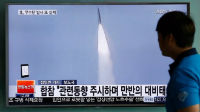 Last Saturday, a North Korean submarine fired a ballistic missile while submerged off the country’s eastern coast. The missile was successfully ejected from the submarine but the missile was believed to have failed in its initial flight stage. This was the second North Korean failure to launch a missile from a submarine in the last three months. The United States and South Korea both condemned the launch.
Last Saturday, a North Korean submarine fired a ballistic missile while submerged off the country’s eastern coast. The missile was successfully ejected from the submarine but the missile was believed to have failed in its initial flight stage. This was the second North Korean failure to launch a missile from a submarine in the last three months. The United States and South Korea both condemned the launch.
“We strongly condemn North Korea’s missile test in violation of U.N. Security Council Resolutions, which explicitly prohibit North Korea’s use of ballistic missile technology,” said Gabrielle Price, spokeswoman for the U.S. State Department’s Bureau of East Asian and Pacific Affairs.
How dangerous are the latest North Korean submarine-based ballistic missile tests? It is difficult to say. Currently, only one of the estimated around 70 operational vessels including min-subs is capable of launching a ballistic missile, and so far the missiles have failed. How effective the North Korean submarine fleet is, is also an open question. Some analysts consider the submarines to be outdated, decrepit and the greatest threat to their crews. Last March one North Korean sub disappeared and is presumed to have sunk. On the other hand, in 2010 the South Korean Navy corvette Cheonan was sunk by a torpedo presumably from a North Korean midget submarine, killing 46 sailors.
Last August, North Korea set off alarm bells when it suddenly deployed 50 of its 70 submarines, about 70% of the country’s known fleet.
David Axe in the Daily Beast concluded that “North Korea’s new sea-launched, nuclear-capable ballistic missile and the submarine that fires it are both technologically backward, unreliable, and wickedly unsafe for the unfortunate souls tasked with operating them.
...Normal standards of atomic safety and effectiveness don’t apply to North Korea’s totalitarian regime. Pyongyang has nuclear weapons plus at least one submarine that, however unreliably, can launch them. That rudimentary atomic capability is probably all the regime needs to deter the rest of the world… while also bending the international system’s rules for its own benefit.
Call it the nuclear crazy standard. The only standard that matters to a government that would rather spend billions of dollars on unsafe subs and nukes than even attempt to feed its own starving people.”
On Friday, the US and South Korea agreed to deploy a missile defence system to counter threats from Pyongyang. the Terminal High Altitude Area Defense (THAAD) anti-missile system is designed to intercept incoming ballistic missiles. It remains unclear exactly where the THAAD will be sited and who will have final control over the new system.
South Korea currently operates a submarine fleet of nine diesel-electric Jang Bogo-class and six Son Wonil-class Type 214 hybrid diesel-electric/fuel cell vessels with air-independent propulsion (AIP). An additional three Type 214 boats are expected to be delivered before 2020.

Third paragraph, second line. What?
Currently, only of the estimated around 70 operational vessels including min-subs is capable of launching a ballistic missile, and so far the missiles have failed.